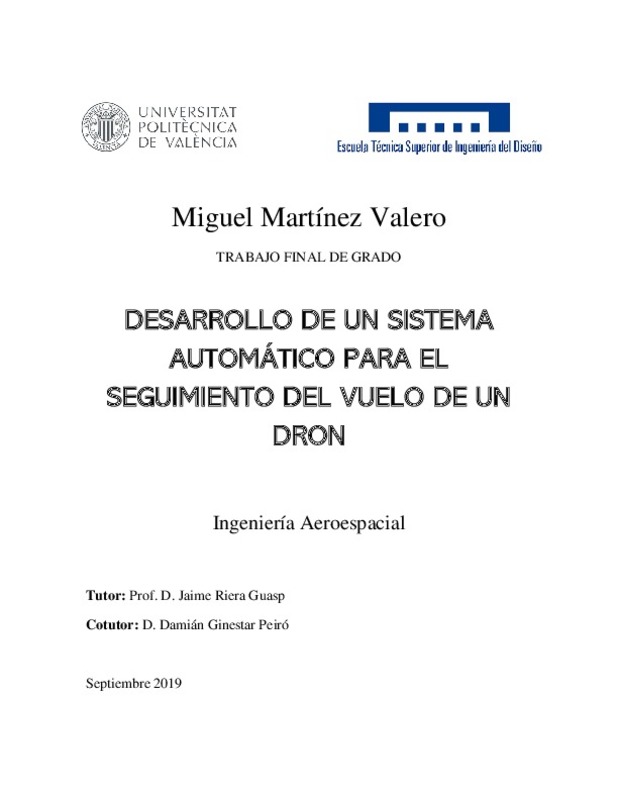JavaScript is disabled for your browser. Some features of this site may not work without it.
Buscar en RiuNet
Listar
Mi cuenta
Estadísticas
Ayuda RiuNet
Admin. UPV
Desarrollo de un sistema automático para el seguimiento del vuelo de un dron
Mostrar el registro sencillo del ítem
Ficheros en el ítem
| dc.contributor.advisor | Ginestar Peiro, Damián
|
es_ES |
| dc.contributor.advisor | Riera Guasp, Jaime
|
es_ES |
| dc.contributor.author | Martínez Valero, Miguel
|
es_ES |
| dc.date.accessioned | 2019-10-11T10:27:37Z | |
| dc.date.available | 2019-10-11T10:27:37Z | |
| dc.date.created | 2019-09-20 | |
| dc.date.issued | 2019-10-11 | es_ES |
| dc.identifier.uri | http://hdl.handle.net/10251/128053 | |
| dc.description.abstract | [ES] La industria de las aeronaves pilotadas por control remoto (RPAs) y, en concreto, la de los drones, se encuentra en su apogeo. Por ello, surge la necesidad de descubrir modelos matemáticos capaces de definir la trayectoria de estos vehículos aéreos. El presente Trabajo de Fin de Grado (TFG) desarrolla un procedimiento analítico para predecir el itinerario de un cuadricóptero en función de los parámetros geométricos y las actuaciones de sus rotores. Con este fin, se explican los fenómenos presentes en la intervención de un dron, se estudia el comportamiento del aire alrededor de las hélices para definir la tracción generada por estas y se caracterizan los motores del modelo Cheerwing Syma XS5W-V3. A partir de la grabación de dos despegues realizados por este cuadricóptero, se comprueba que es posible pronosticar con un programa de simulación la trayectoria ejecutada. Para acabar, se definen los costes del proyecto y la normativa a tener en cuenta durante su realización. | es_ES |
| dc.description.abstract | [EN] The industry of remotely piloted aircraft (RPAs) and, specifically, the one that investigates drones, is in full swing. Therefore, there is a need to discover mathematical models capable of defining the trajectory of these aerial vehicles. This Final Degree Project (TFG) develops an analytical procedure to predict the itinerary of a quadcopter based on the geometric parameters and the actions of its rotors. To achieve this, the phenomena present in the intervention of a drone are explained, the behavior of the air around the propellers is studied to define the traction generated by them and the engines of the Cheerwing Syma XS5W-V3 model are characterized. From the recording of two take-offs carried out by this quadcopter, it is verified that it is possible to predict with a simulation program the trajectory executed. Finally, the costs of the project and the regulations to be considered during its implementation are commented. | es_ES |
| dc.format.extent | 132 | es_ES |
| dc.language | Español | es_ES |
| dc.publisher | Universitat Politècnica de València | es_ES |
| dc.rights | Reserva de todos los derechos | es_ES |
| dc.subject | Dron | es_ES |
| dc.subject | Cuadricóptero | es_ES |
| dc.subject | Despegue | es_ES |
| dc.subject | Trayectoria | es_ES |
| dc.subject | Drone | es_ES |
| dc.subject | Quadcopter | es_ES |
| dc.subject | Take-off | es_ES |
| dc.subject | Trajectory | es_ES |
| dc.subject.classification | FISICA APLICADA | es_ES |
| dc.subject.classification | MATEMATICA APLICADA | es_ES |
| dc.subject.other | Grado en Ingeniería Aeroespacial-Grau en Enginyeria Aeroespacial | es_ES |
| dc.title | Desarrollo de un sistema automático para el seguimiento del vuelo de un dron | es_ES |
| dc.type | Proyecto/Trabajo fin de carrera/grado | es_ES |
| dc.rights.accessRights | Abierto | es_ES |
| dc.contributor.affiliation | Universitat Politècnica de València. Departamento de Física Aplicada - Departament de Física Aplicada | es_ES |
| dc.contributor.affiliation | Universitat Politècnica de València. Escuela Técnica Superior de Ingeniería del Diseño - Escola Tècnica Superior d'Enginyeria del Disseny | es_ES |
| dc.description.bibliographicCitation | Martínez Valero, M. (2019). Desarrollo de un sistema automático para el seguimiento del vuelo de un dron. Universitat Politècnica de València. http://hdl.handle.net/10251/128053 | es_ES |
| dc.description.accrualMethod | TFGM | es_ES |
| dc.relation.pasarela | TFGM\97617 | es_ES |
Este ítem aparece en la(s) siguiente(s) colección(ones)
-
ETSID - Trabajos académicos [8898]
Escuela Técnica Superior de Ingeniería del Diseño






